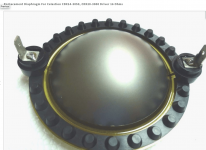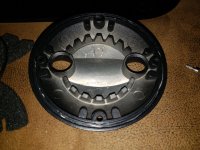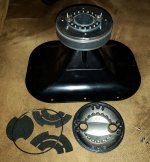Working with some Celestion CDX1-1745 compression drivers. Noticing some odd distortion when I wiggle the positive + input terminal, which at lower frequencies causes some odd order harmonics. It sounds alot like a rubbing misaligned VC. At first it showed up constantly when I was sweeping the driver down low and I could change the seventy of distortion if I pushed sideways on the + terminal.
I decided to pull the diaphragm and look the VC gap over for any loose debris and clean it out just to be thorough. I did find some adhesive residue around the centering flange, so I thought to myself that was likely the issue. After putting it all back together and carefully / evenly torquing the rear chamber cover back up, it sounded better. However, when I lightly push sideways on the + terminal, it still distorts a little. Its not nearly as bad as before but its there. The second driver I have doesn't distort at all when I apply sideways pressure on either terminal, but both drivers are very microphonic when tapping or flicking only the positive + terminal. This has to be some kind of engineering issue being that both drivers behave this way and the amount of microphonics from the terminal is of concern. The whole diaphragm is clamped with this dimpled "sound castle" rubber edging around the whole assembly. Maybe its too compliant overall, but the - negative terminal doesn't exhibit this behavior, so i don't understand why they would let a design like this slide. Eventually the strain and vibration on the microphonic terminal by the wiring will weaken the terminal mounting and cause the VC to fail.
Anyone else notice this on their drivers?
I decided to pull the diaphragm and look the VC gap over for any loose debris and clean it out just to be thorough. I did find some adhesive residue around the centering flange, so I thought to myself that was likely the issue. After putting it all back together and carefully / evenly torquing the rear chamber cover back up, it sounded better. However, when I lightly push sideways on the + terminal, it still distorts a little. Its not nearly as bad as before but its there. The second driver I have doesn't distort at all when I apply sideways pressure on either terminal, but both drivers are very microphonic when tapping or flicking only the positive + terminal. This has to be some kind of engineering issue being that both drivers behave this way and the amount of microphonics from the terminal is of concern. The whole diaphragm is clamped with this dimpled "sound castle" rubber edging around the whole assembly. Maybe its too compliant overall, but the - negative terminal doesn't exhibit this behavior, so i don't understand why they would let a design like this slide. Eventually the strain and vibration on the microphonic terminal by the wiring will weaken the terminal mounting and cause the VC to fail.
Anyone else notice this on their drivers?
The two Celestion CDX14-3050 I owned had quite different frequency response, but not the issue you report.
Looking at photos of the CDX1-1745 diaphragm compared to the CDX14-3050, it appears there may be very little clearance at this point:

Any debris there, or not enough space, could cause results like you mention when the terminal is rocked inward.
About a millimeter clearance may be required to avoid buzzing.
There also could be some debris or miscasting (or loss of elasticity) preventing a proper air seal around the terminal. An air leak in such a small compression chamber can make funny sounds. The red terminal paint may be affecting the elastomeric, I have experienced a lot of problems with drive belts and such turning to mush when exposed to other out-gassing plastics.
Wrapping some Teflon thread seal tape (plumber's tape) around the terminals might be a fix if you don't find any crud preventing a seal.
Magnifying glasses, or taking pictures and blowing them up on screen can be a help finding these little problems...
Art

Looking at photos of the CDX1-1745 diaphragm compared to the CDX14-3050, it appears there may be very little clearance at this point:
Any debris there, or not enough space, could cause results like you mention when the terminal is rocked inward.
About a millimeter clearance may be required to avoid buzzing.
There also could be some debris or miscasting (or loss of elasticity) preventing a proper air seal around the terminal. An air leak in such a small compression chamber can make funny sounds. The red terminal paint may be affecting the elastomeric, I have experienced a lot of problems with drive belts and such turning to mush when exposed to other out-gassing plastics.
Wrapping some Teflon thread seal tape (plumber's tape) around the terminals might be a fix if you don't find any crud preventing a seal.
Magnifying glasses, or taking pictures and blowing them up on screen can be a help finding these little problems...
Art

Last edited:
That is EXACTLY what I needed to know. I suspected it was a clearance issue with something around the diaphragm, as I could not find anything wrong with the VC alignment in the gap.
What do you think is the smartest way to add clearance in this area to reliably fix the flaw? I can't believe Celestion would let this go from an engineering point of view. The driver is otherwise well designed IMO, but this is a huge let down.
What do you think is the smartest way to add clearance in this area to reliably fix the flaw? I can't believe Celestion would let this go from an engineering point of view. The driver is otherwise well designed IMO, but this is a huge let down.
If it is a clearance issue, cutting a clearance arc like the CDX14-3050 has above the lead-out wire with a #1 X-ACTO knife would do the trick.

Practice cutting some plastic and rubber first if you haven't whittled for a while !
Art
Practice cutting some plastic and rubber first if you haven't whittled for a while !
Art
As much as I was hoping the above scenario is the issue, I'm sad to say the problem persists. My diaphragms have more than 1mm clearance in the area of concern.
I've removed the dampening material and o-ring from the rear cover and ran the driver again. The issue I'm seeing is insufficient clamping at the positive terminal side. There isn't enough compression of the diaphragm assembly at that location, which is why the positive terminal is so sensitive to external vibration. Pushing on the positive terminal inwards causes the whole VC assembly to flex and misalign in the VC gap. If I rotate the cover 180 degrees, the negative terminal becomes more sensitive, telling me its an issue with the cover itself.
The proposed solution is to sand down the rear cover a bit to get more compression and even clamping from the teeth of the rear cover onto the diaphragm dimples. Checking the rear cover for flatness, there is some wiggle when I place it face down onto my granite measurement block surface.
I've removed the dampening material and o-ring from the rear cover and ran the driver again. The issue I'm seeing is insufficient clamping at the positive terminal side. There isn't enough compression of the diaphragm assembly at that location, which is why the positive terminal is so sensitive to external vibration. Pushing on the positive terminal inwards causes the whole VC assembly to flex and misalign in the VC gap. If I rotate the cover 180 degrees, the negative terminal becomes more sensitive, telling me its an issue with the cover itself.
The proposed solution is to sand down the rear cover a bit to get more compression and even clamping from the teeth of the rear cover onto the diaphragm dimples. Checking the rear cover for flatness, there is some wiggle when I place it face down onto my granite measurement block surface.
Attachments
Last edited:
Sounds like a solution to the problem.Pushing on the positive terminal inwards causes the whole VC assembly to flex and misalign in the VC gap. If I rotate the cover 180 degrees, the negative terminal becomes more sensitive, telling me its an issue with the cover itself.
The proposed solution is to sand down the rear cover a bit to get more compression and even clamping from the teeth of the rear cover onto the diaphragm dimples. Checking the rear cover for flatness, there is some wiggle when I place it face down onto my granite measurement block surface.
In an attempt to reduce parts count and speed assembly, the design is dependent on the "sound castle" elastomeric properties for the seals.
While you are correcting the mis-cast back plate, might also file off the "O-ring deflector™", which reduces it's contact area, a potential pinch point that could prevent the back plate from fully sealing the terminal rings.
Art
Thanks for the tips Art!
I was looking at that area with some concern. While I like the fact they opted for an o ring seal, I don't like the design which causes a deflective stresses in the back cover flange.
I may just get rid of the oring and use a skim of RTV to do job and also a small amount around the terminals in an effort to add some support at the same time. I also may skim the outer edge of the VC locating flange with black RTV. I've done this on many other CD diaphragms with great success, based on before and after HD measurements specifically in the lower frequencies near fundamental driver resonance. This Celestion CD looks to be otherwise well designed, but the way they designed the diaphragm retaining system leaves alot to be desired.
The first thing I do when dealing with a new to me CD is test with lower mid frequency sine waves and listen for any weirdness and distortion. That in itself will reveal alot of faults and in most cases avoid any engineering issues leading to premature driver failure.
I was looking at that area with some concern. While I like the fact they opted for an o ring seal, I don't like the design which causes a deflective stresses in the back cover flange.
I may just get rid of the oring and use a skim of RTV to do job and also a small amount around the terminals in an effort to add some support at the same time. I also may skim the outer edge of the VC locating flange with black RTV. I've done this on many other CD diaphragms with great success, based on before and after HD measurements specifically in the lower frequencies near fundamental driver resonance. This Celestion CD looks to be otherwise well designed, but the way they designed the diaphragm retaining system leaves alot to be desired.
The first thing I do when dealing with a new to me CD is test with lower mid frequency sine waves and listen for any weirdness and distortion. That in itself will reveal alot of faults and in most cases avoid any engineering issues leading to premature driver failure.
The major culprit I discovered is the powder coating on the back cover flange being applied too thick and uneven. Verifying with feeler gauges, there is insufficient clamping of the diaphragm and its terminals, allowing vibration to make its way into the diaphragm assembly. This also causes distortion at lower frequencies and can be mistaken for a rubbing VC.
Here's what i did to fix the issue on the CDX1-1745
Remove the oring and dampening foam from the driver rear cover. Place the rear cover onto the driver with the diaphragm in place. Applying light pressure onto the cover, slide a thin feeler gauge (between .001 - .002" thick) at various points under the cover flange, making note of where the gauge is too tight to fit and where it's excessively loose. Usijg a sheet of 400 grit sandpaper on a very flat surface (glass table top or similar will work just fine), sand the cover flange down evenly in a circular pattern until you see bare metal shining through. Wash the cover with water to avoid contamination of the driver, blot it dry with a paper towel and perform the feeler gauge measurement again. Repeat this process until you have an even .001 - .002" gap around the perimeter of the rear cover. Wash the rear cover thoroughly and reassemble, then sweep with sine wave between 500 - 2k to verify problem is resolved. I had to sand until I had an even showing of bare metal around the flange to obtain .002" preload of the diapragm, which is where you want to be for just enough clamping of diaphragm assembly. You should also not be able to hear any noise transmitted through the driver throat when flicking the terminals with your finger nails.
Here's what i did to fix the issue on the CDX1-1745
Remove the oring and dampening foam from the driver rear cover. Place the rear cover onto the driver with the diaphragm in place. Applying light pressure onto the cover, slide a thin feeler gauge (between .001 - .002" thick) at various points under the cover flange, making note of where the gauge is too tight to fit and where it's excessively loose. Usijg a sheet of 400 grit sandpaper on a very flat surface (glass table top or similar will work just fine), sand the cover flange down evenly in a circular pattern until you see bare metal shining through. Wash the cover with water to avoid contamination of the driver, blot it dry with a paper towel and perform the feeler gauge measurement again. Repeat this process until you have an even .001 - .002" gap around the perimeter of the rear cover. Wash the rear cover thoroughly and reassemble, then sweep with sine wave between 500 - 2k to verify problem is resolved. I had to sand until I had an even showing of bare metal around the flange to obtain .002" preload of the diapragm, which is where you want to be for just enough clamping of diaphragm assembly. You should also not be able to hear any noise transmitted through the driver throat when flicking the terminals with your finger nails.
Last edited:
- Home
- Loudspeakers
- Multi-Way
- Celestion CDX1-1745 questions and issues

